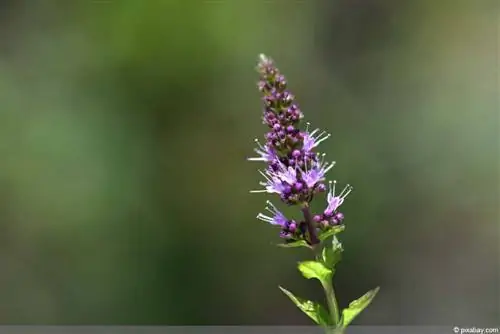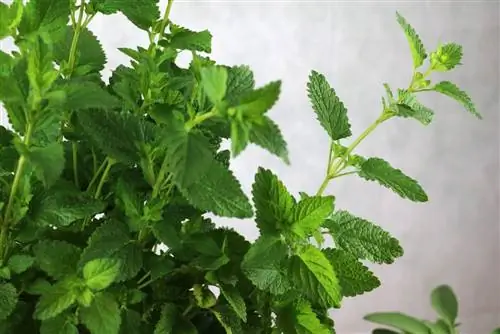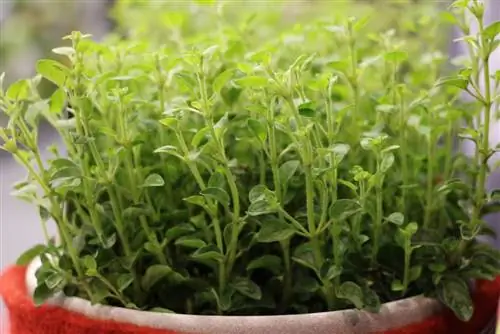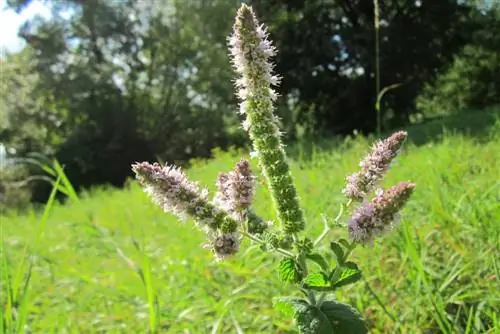- Author admin [email protected].
- Public 2023-12-17 03:39.
- Last modified 2025-01-24 12:45.
Peppermint is widespread and has established itself as a popular medicinal herb in the preparation of drinks and dishes. In addition to its diverse uses, the plant is also extremely easy to care for. The plant can be cultivated both in the garden bed and in a flower pot on the balcony or terrace. However, there is a persistent rumor in popular belief that peppermint becomes poisonous after it blooms.
Harvest correctly
Peppermint has the botanical name Mentha piperita and belongs to the mint family. The herbal plant can be brewed as tea or used to refine salads. In addition, the spicy leaves are used as an ingredient in delicious cocktails. As soon as the plant has developed enough leaves in spring, some of them can be picked off continuously. However, you should never take too many at once so as not to weaken the plant unnecessarily. At the end of autumn, the plants should be cut down completely to increase their winter hardiness. However, the stalks harvested late are only suitable for consumption when the summer months were very warm and dry. As a result of a cool and rainy summer, peppermint leaves can only produce a slight flavor.
- Removing the leaves early in the morning is ideal
- Pluck carefully from the plant
- Alternatively, cut off whole stems
- Cut the desired stem back very far
- Stems sprout again after harvesting
- In general, peppermint can be harvested until the first frost
- Tastes equally good fresh or dried
- Leaves can be frozen for a long shelf life
Tip:
When harvesting, the stalks must under no circumstances be torn, as pest infestation can quickly spread at this point. Therefore, only sharp and disinfected cutting tools should be used.
Time of harvest

During the flowering period, the peppermint leaves lose their intensity in terms of taste, as the herb plant invests all of its strength in the development of the flowers. The flowers then produce seeds, which are used for reproduction. This is a crucial process in the life of the plant, more important than the continuous sprouting of new leaves. That's why the leaves contain far fewer essential oils during the flowering phase and lose their distinctive mint taste. If the plant becomes too large, it should be cut back generously at several times. However, the leaves must not be consumed if they are infested with diseases or pests. In this case, appropriate control measures must first be taken before the plant is suitable for consumption again.
- Small quantities can be harvested continuously
- Remove more leaves in spring
- Harvest a large part of the leaves before flowering
- Individual leaves can also be harvested during the flowering period
- Then the leaves have a less intense taste
- Plant never becomes poisonous
- After the leaves fade, the taste of the leaves becomes bitter
- Even then, these can still be harvested
- Cut back heavily if growth is rampant
- Heavy pruning possible until September or October, depending on the weather
Tip:
If the leaves were harvested during the flowering period and taste extremely bitter, then they should not be consumed fresh. In this case, drying the leaves is a good idea, as this causes them to lose some of their bitter taste.
Flowering time
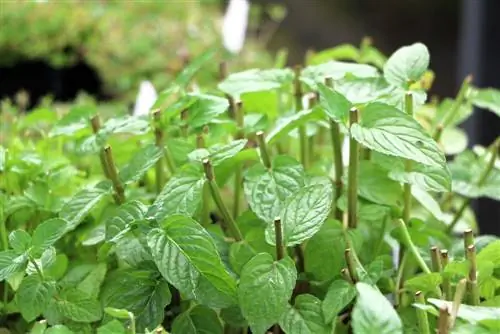
The flowering time can vary depending on sowing and weather. A rumor has spread among amateur gardeners that peppermint leaves can no longer be harvested at this point because the plant then becomes poisonous. However, this rumor definitely does not correspond to the facts. After flowering, seeds can be collected from the flowers, but only if the plant has been fertilized beforehand. The completely dried flowers should then be picked very carefully from the plant and shaken out gently. The seeds inside then fall out on their own.
- Usually blooms between June and August
- Can bloom until September during warm weather conditions
- Produces small and white-pink flowers
- Leaves are then less aromatic, but not poisonous
- Tastes a little bitterer during and after flowering
- Seeds for reproduction are formed in the flowers
Edible flowers
In addition to the leaves of peppermint, the flowers can also be eaten. However, the flowers lack the spicy aromatics, which is why they are not particularly suitable for brewing peppermint tea. In addition, the flowers are also not suitable for making peppermint oil because they contain almost no essential oils.
- Flowers are suitable as an ingredient for sweet dishes
- Can be made into jam and syrup
- Give the summer punch a fresh flavor
- Beautiful to look at as a spicy garnish on the salad

